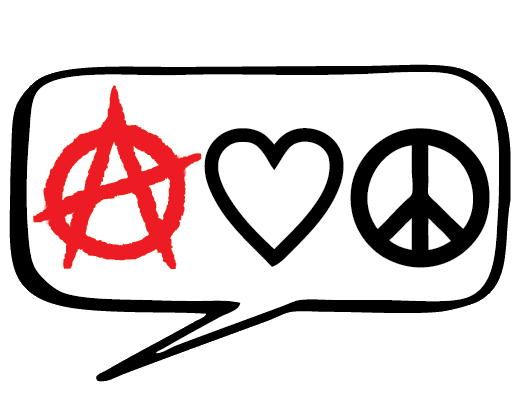February 2025 🤗 🚧 Under construction, please visit us again soon! 🚧
Back to main page

Overview of Nonviolent Anarchist History
A super brief history of anarchism
- First published anarchist theory 1793
- First published use of the word “anarchist” 1840
- The anarchist movement definitively splits from the Marxist movement 1872
- The Haymarket affair in the U.S. 1886
- Ukrainian anarchist revolution 1918 to 1921
- Spanish anarchist revolution 1936 to 1939
History / tradition / lineage of nonviolent anarchism
Early Nonviolent Anarchism
World War II Era
- Bart de Ligt (1883 - 1938) was a Dutch anarcho-pacifist and antimilitarist. He is chiefly known for his support of conscientious objectors. His book The Conquest of Violence was read widely by British and American pacifists during the 1930s and led many of them to adopt an anarchistic point of view.
- Gandhi (1869-1948) and Satyagraha, a particular form of nonviolent resistance
- Dorothy Day (1897-1980) and the Catholic Worker movement
Post-War Era
- Paul Goodman (1911-1972)
- The Human Potential Movement (HPM) arose out of a synthesis of Humanistic psychology and the counterculture of the 1960s. It is formed around the concept of an extraordinary potential that its advocates believed to lie largely untapped in all people. Some people in the HPM considered themselves to be anarchist.
- The French anarcho-pacifists: Charles-Auguste Bontemps (1893 - 1981) Naturism, Jean-René Saulière (1911 - 1999) the right to suicide, Gérard de Lacaze-Duthiers (1876 - 1958) "All men should be artists"
- Jacques Ellul "By anarchy I mean first an absolute rejection of violence." Also attributed to Ellul: "Think globally, act locally." La Technique: L'enjeu du siècle (literally, "The Stake of the Century"), English title: The Technological Society (1964)
- George Woodcock (1912–1995)
- Alex Comfort (1920–2000)
- David Dellinger (1915–2004) and revolutionary nonviolence
- The Living Theatre was a theater company that was founded in 1947 by Julian Beck (1925 -1985) and Judith Malina (1926 - 2015) with the goal of creating the Beautiful Non-Violent Anarchist Revolution. The company's work was characterized by its radical pacifist and anarchist ideologies, and its use of provocative gestures, collaborative creation of scripts, audience participation and nudity to challenge societal norms.
1970s & '80s
- Movement for a New Society (1971–1988)
- Food Not Bombs, founded in 1980, central beliefs are:
- Meals are free to anyone.
- Each chapter is independent and autonomous and makes decisions via consensus.
- Dedication to nonviolence.
- Food is a right not a privilege.
- Goals:
- To combat poverty and homelessness
- To facilitate community gatherings of hungry people
- To allow anyone to volunteer to help cook, and then eat.
- Robert Baker Aitken (1917–2010), Buddhist Peace Fellowship and Buddhist anarchism
https://www.bpf.org/about-bpf/history
- Crass (1977–1986) and peace punk
Contemporary Times
- Utah Phillips (1935–2008)
- Ursula K. Le Guin (1929–2018)
- Peace News — British anarcho—pacifist magazine, 1936–2024
- Starhawk
NVC-inspired
- NVC and anarchism
- Dominic Barter and Restorative Circles
- Miki Kashtan, NGL, NVC for Liberation, NVC with a systemic lens
- Party of Life — Jim Raymond, others

